Best Longganisa in the Philippines: Top Picks for Meat Lovers
Longganisa is a popular Filipino sausage that is enjoyed throughout the country. It is made with ground pork, garlic, and other seasonings and is usually served with rice and a fried egg for breakfast. While many different types of longganisa are available in the Philippines, some stand out as the best.

One of the most popular Filipino sausages is Lucban longganisa. This sausage comes from Lucban in Quezon province and is known for its unique flavor. It is made with a blend of pork, garlic, and other spices and is often slightly sour. Lucban longganisa is a must-try for anyone visiting the Philippines.
Another popular type of Filipino longganisa comes from Vigan. This sausage from Ilocos Sur is known for its garlicky flavor. It is made with coarsely ground pork and is often smoked or dried before being cooked. Vigan longganisa is a favorite among locals and visitors and is usually served with vinegar and Papaya pickles.
History of Longganisa
Longganisa is integral to the country’s culinary culture and has a long and fascinating history.
Longganisa originated in the 16th century when Spanish settlers brought pork sausages to the Philippines. The word “longganisa” was derived from the Spanish term “longaniza,” which is a type of Spanish sausage like the Chorizo.
Over time, Filipinos have adapted the recipe and created unique varieties of longganisa. Each region in the Philippines has its own version of longganisa, with different flavors and ingredients. Some are sweet, while others are spicy. Some are made with vinegar, while others use soy sauce or sugar.
Longganisa has become a staple breakfast food in the Philippines, often served with garlic rice and a fried egg. It is also used as an ingredient in Filipino dishes such as toppings for pancit, and sauteed vegetables.
Today, longganisa is not only enjoyed in the Philippines but also by Filipinos living abroad and people from other countries who have discovered its delicious taste. It has become a symbol of Filipino cuisine and culture and a must-try for anyone visiting the Philippines.
Regional Varieties of Longganisa
Longganisa is a popular Filipino sausage that comes in various regional varieties. Each region has its unique way of preparing and seasoning the sausage, resulting in different flavors and textures. Here are some of the most popular regional varieties of longganisa in the Philippines:

Vigan Longganisa
Known for its garlicky flavor and distinct aroma, Vigan longganisa is made with ground lean pork, ground pork fat, brown sugar, garlic, onions, bay leaves, soy sauce, vinegar, black pepper, and salt to taste and stuffed into hog casings. Chili flakes may also be added for an extra kick of flavor.
The sausages are then hung to dry and served with garlic rice and vinegar dipping sauce. The unique flavor of Vigan longganisa has earned it a place of honor in the city, with the annual “Longganisa Festival” celebrating the sausage and its cultural significance.

Lucban Longganisa
Lucban Longganisa is a famous type of sausage hailing from Lucban in Quezon province. It has a distinctive flavor, combining ground pork, garlic, oregano, paprika, and other spices, and is stuffed into hog casings before being hung to dry.
The unique taste of Lucban Longganisa is slightly sweet and tangy and is often served with garlic rice and a vinegar dipping sauce. But what makes Lucban Longganisa truly special is the addition of oregano and paprika to the mix, giving the sausage a deeper flavor that hints at European influences.
According to historian Jojo Raneses, the local cook Juan Suarez taught the people of Lucban how to make longganisa. He had been brought to Mexico, where he learned about chorizo de Bilbao. After experimenting with banana leaves and egg whites as casings, Suarez eventually perfected the recipe that is still enjoyed today.
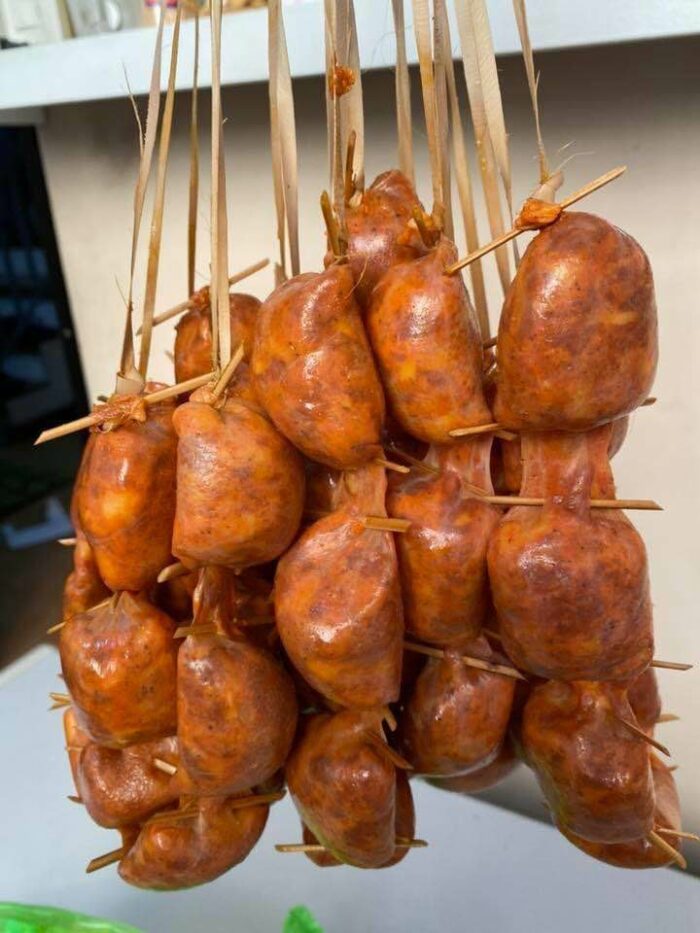
Alaminos Longganisa
Alaminos Longganisa is an iconic Filipino pork sausage originating from the city of Alaminos in Pangasinan province. The unique blend of ground pork, garlic, and a variety of spices, including black pepper and anise, gives it a savory and slightly sweet flavor that is truly unforgettable.
Alaminos Longganisa is stuffed into hog casings and hung to dry, giving it a salty, garlicky, and tangy taste. The orange color of the sausage comes from the addition of atsuete.
To enjoy the full flavor of this traditional Filipino sausage, it is typically served with garlic rice and a vinegar dipping sauce. Enjoy the authentic taste of Alaminos Longganisa today!

Chorizo de Macao
Chorizo de Macao, also known as Chinese Chorizo or Longaniza Macau, is a Filipino dry pork sausage used in various Chinese-Filipino dishes.
It is made with the same ingredients as other Filipino sweet longganisas (longganisa hamonado) but with a dry texture and a hint of star anise, aniseed, or anise liqueur (anisado) for a unique aroma. You can find this distinctive sausage in dishes like pancit Canton and siopao, and it is often mistaken for Chinese sausage.

Cebu Longganisa | Chorizo de Cebu
Cebu Longganisa, a Filipino pork sausage from the Cebu province, is a delicacy made with ground pork, garlic, and a variety of spices, including black pepper and oregano. It is stuffed into hog casings and hung to dry, giving it a slightly sweet and spicy flavor.
Chorizo de Cebu, or longganisa de Cebu, is a type of hamonada longganisa that is distinctively red in color due to the use of achuete seeds. Each link is usually spherical and made from lean pork, pork fat, salt, saltpeter, sugar, anise liqueur (anisado), paprika, black pepper, garlic, and chilis.
Enjoy the savory goodness of Cebu Longganisa, fried or grilled with white rice, puso, or garlic rice, served with a vinegar dipping sauce for a delicious breakfast or snack.
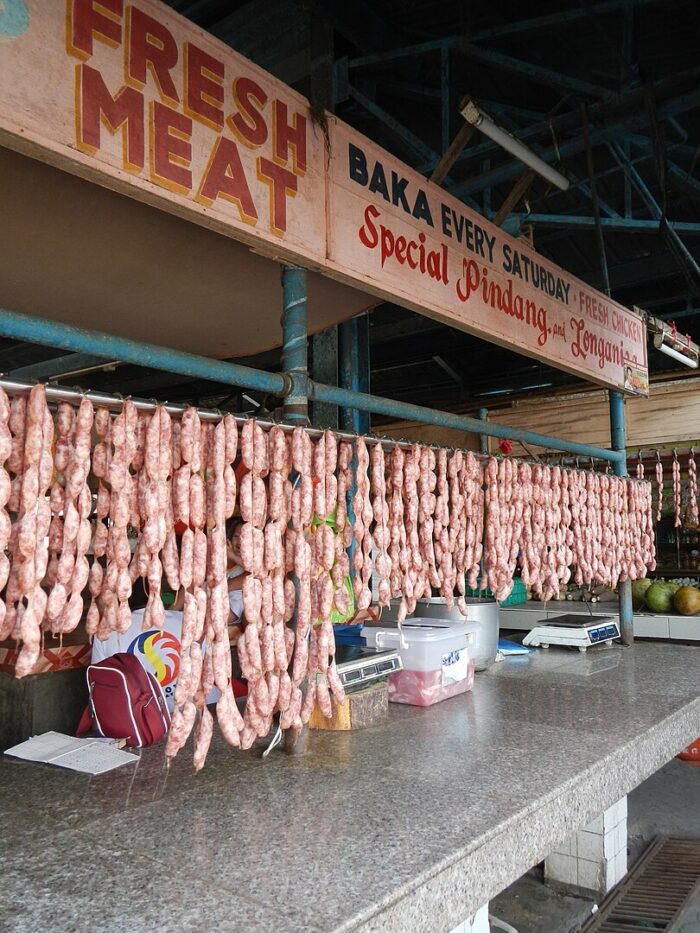
Pampanga Longganisa
Pampanga Longganisa, a sweet and slightly spicy Filipino pork sausage originating from the province of Pampanga, is longer and thinner than other Philippine sausages.
It is made with a combination of ground pork, garlic, paprika, sugar, black pepper, coarse salt, and vinegar and is stuffed into hog casings and hung to dry, giving it a unique flavor. Enjoy Pampanga Longganisa with garlic rice and vinegar dipping sauce for a truly unforgettable culinary experience.
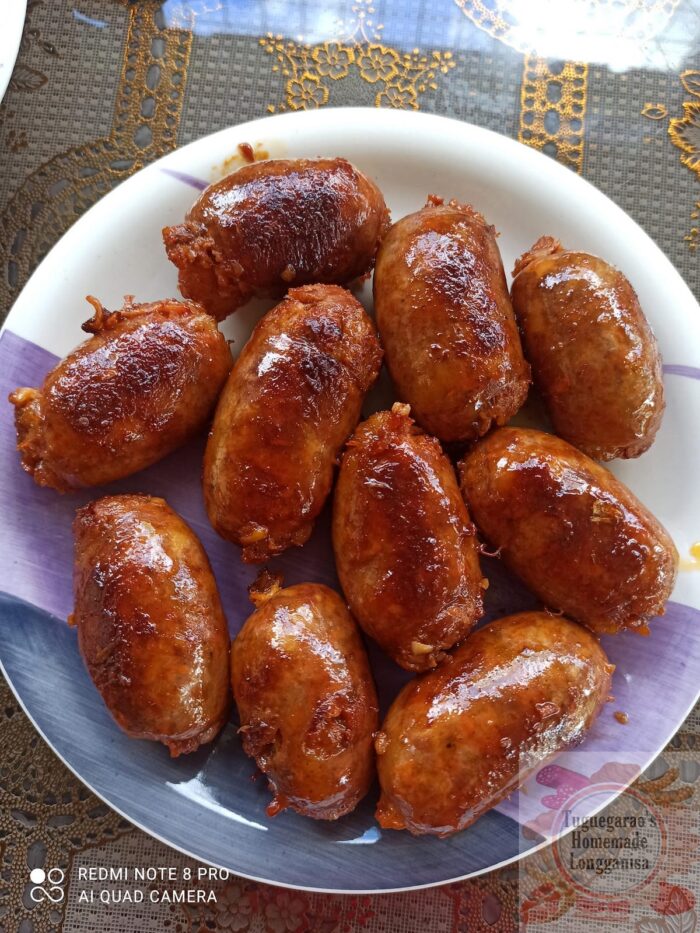
Tuguegarao Longganisa
Tuguegarao Longganisa is a Filipino sausage originating from the Cagayan Valley region in the northern part of the Philippines. This sausage is known for its distinct sourness from the vinegar marinade used in its preparation.
One of the unique features of Tuguegarao Longganisa is its yellowish or orange color, which is produced by adding atsuete or annatto. The meat is less finely ground, resulting in larger pieces of meat in the sausage.
Tuguegarao Longganisa is often served with fried rice and fried egg, a popular Filipino breakfast dish called “silog.” It is also a staple ingredient in Filipino dishes such as “pinakbet,” a vegetable stew.
If you want to try Tuguegarao Longganisa, some popular brands include Aica’s Authentic Tuguegarao Longganisa and G&B Tuguegarao Longganisa. You can also find this sausage in local markets and restaurants in the Cagayan Valley region.

Imus Longganisa
In Cavite, the City of Imus has its own version of longganisa. The famous adobo-style Imus Longganisa is made of fresh meat, soy sauce, vinegar, annatto, and black pepper, filled in natural sausage casing.
Big Ben’s Original Garlic Adobo Longganisa is an underrated delicacy yet a local favorite in Imus, Cavite. It combines soy sauce, vinegar, annatto, and black pepper, uniquely giving the mostly lean pork a perfect balance of salty and sour flavors – the ideal accompaniment to nipa palm vinegar, making for an unforgettable “longsilog” breakfast experience during your visit to Cavite.
Lola Maria is another famous brand of longganisa in Imus, which is meticulously crafted with love and care to create the perfect sausages. From farm to fork, their homemade longganisa undergoes quality control to ensure every bite is flavorful and packed with goodness.
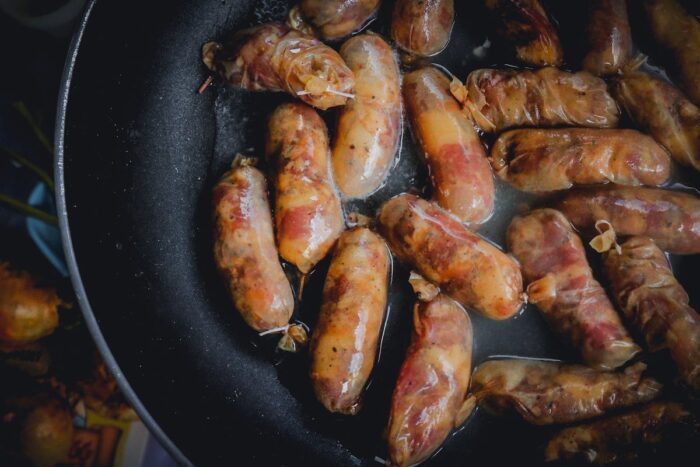
Guinobatan Longganisa
Longganisa de Guinobatan is a unique type of Filipino pork sausage hailing from the town of Guinobatan in Albay, Philippines. Each sausage link measures only 2 inches (5.1 cm) in length and is made from a special recipe of lean pork, pork fat, salt, sugar, garlic, saltpeter, and black pepper.
The meat is chopped by hand, giving the sausage unique flavor and texture. Each year, Guinobatan celebrates a festival dedicated to delicious sausage with the “Longganisa Festival.” The original recipe dates back to 1945 when Danding (Bigote) Nosares created a unique recipe for processed meat.
His was the first Guinobateño-made Special Longganisa, made from cubed pork with a heavy garlic flavor. For decades, Special Longganisa was only available upon order, with regular customers being tourists and balikbayans. However, with the help of the DTI, Danding’s daughter, Carmen Nosares-Ravago, has since improved the recipe, now using pork hind leg (pigue) and indigenous ingredients (no preservatives).
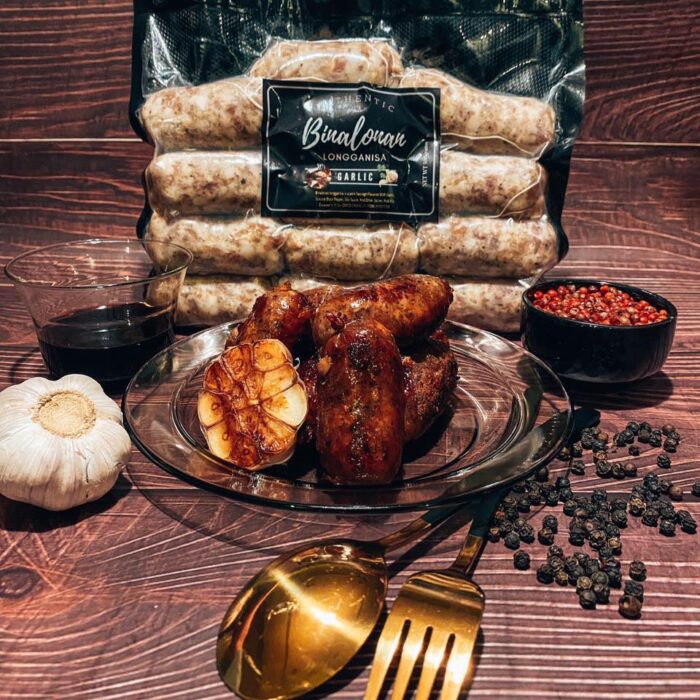
Binalonan Longganisa
The Binalonan version of Longganisa has been a local favorite and a must-try for visitors. This savory delicacy is made with fresh pork, black pepper, and garlic, giving it a unique and mouth-watering flavor. Its meaty, garlicky taste is irresistible, and it’s best enjoyed with a dip of vinegar, banana ketchup, or a combination of soy sauce and calamansi.
As the demand for Binalonan Longganisa has grown, local meat vendors have maintained the original recipe passed down from generation to generation. Restaurants in the area have also added Longganisa dishes to their menu.
In 2015, the Binalonan administration even launched the Longganisa Festival to celebrate the booming industry and give locals the chance to showcase different Longganisa-based dishes.

Cabanatuan Longganisa (Batutay)
Cabanatuan Longganisa, also known as Batutay, Bototay, or Batotay depending on the municipality. It is a Filipino pork sausage from Cabanatuan in the province of Nueva Ecija and is made with ground beef instead of the usual pork. It has a sweeter taste, giving the sausage a great balance between savory and sweet.
This delicacy is celebrated in the annual “Longganisa Festival” of Cabanatuan. It is credited to Dorothea Lajares, who created the recipe in 1952 when she started Aling Otya’s Longganisa at the Cabanatuan Public Market.
Aling Otya’s is one of the more famous promoters of longganisa in Cabanatuan and is known to sell the classic longganisa, as well as garlic, spicy, and hamonado varieties, and eventually the batutay. Since then, it has become a beloved part of Filipino cuisine.

Baguio Longganisa
Baguio Longganisa is a Filipino pork sausage originating from the city of Baguio. It is a type of Hamonado (sweet) Longganisa, and it has two versions: the garlic de recado type and the sweet jamonado version.
Baguio Premium Longganisa of Baguio Country Club has been a favorite amongst many tourists visiting the city of Pines. According to the makers, they have decreased their Longganisa’s fat content to 20%, making it leaner, tastier, and healthier.
Furthermore, their recipe contains no preservatives or extenders, and they wish for everyone to have a full farm-to-table experience, even in their own homes.

Aklan Longganisa – Chorizo De Kalibo
For centuries, Aklan Longganisa has been a beloved delicacy of the people of Western Visayas. This flavorful Filipino sausage is native to the province of Aklan and is a specialty of the region. This simple yet delicious sausage is made from ground pork, garlic, pepper, and other spices.
The pork is ground twice to ensure a fine texture, while the garlic and pepper add a unique flavor. It is usually served as a breakfast dish, and its history dates back to when Spanish colonizers brought the ingredients and recipes to the Philippines. Aklan longganisa is mildly spicy due to the black pepper and garlic, and you can adjust the level of spiciness by adding more or less black pepper. For those who appreciate good food, Aklan Longganisa is an absolute must-try!
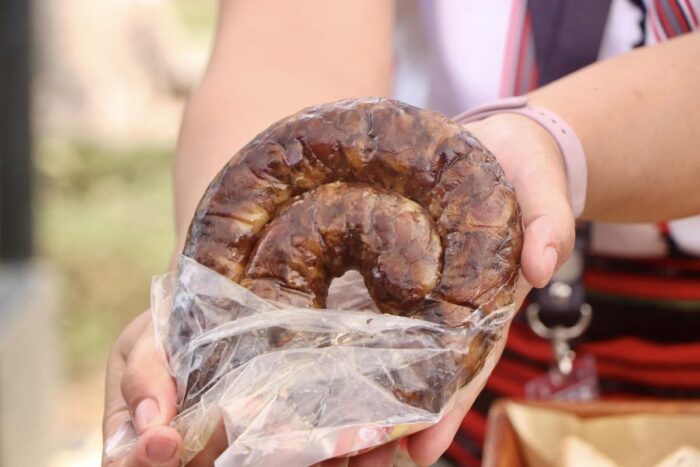
Pinuneg (Cordillera Administrative Region)
For the Kankanaey people of Benguet, Pinuneg is an essential part of their culture. This savory and hearty blood sausage is made with pig’s blood, innards, and spices and is traditionally served after a ritual or ceremony.
Pinuneg offers a unique texture, with a chewy combination of pig blood and spices wrapped in a clean, empty pig’s large intestine. While it may not be for everyone, this Cordilleran delicacy is boiled for 30-35 minutes to bring out its flavor and can even be served with a hint of chili or vinegar for a bit of added spice.
Pinuneg has been part of the Kankanaey tradition long before the Spaniards arrived in the Philippines, so it’s no surprise that it remains a beloved dish for many Cordillerans today.

Taal Longganisa
Longanizang Taal is a Taal delicacy that is simply irresistible! Marinated with a soy sauce, garlic, sugar, and calamansi blend, this delectable chunky sausage has Taaleños returning for more. At the public market, you can find stalls of Longaniza ready to cook, marinated for maximum flavor.
The authentic Taal Longganisa de rekado is known for its distinct garlicky adobo taste, made from chopped pork and stuffed into lengths of dried skin of intestines.
Witness the process early in the morning at the public market, and you’ll understand why getting enough of this savory Taal delicacy is impossible!

Calumpit Longganisa
Calumpit Longganisa is a type of sausage that originated from Calumpit, a municipality in the province of Bulacan. It is a popular breakfast food in the Philippines, often served with garlic rice and eggs.
Calumpit Longganisa is known for its distinct flavor, combining garlic, salt, and pepper. It also has hints of paprika and brown sugar, which give it a well-rounded flavor profile. Bay leaves and soy sauce are also added to enhance the taste.
Compared to other types of longganisa, Calumpit Longganisa is not too fatty because most Bulacanos use leaner meat. It is also not as sweet as other varieties, making it an excellent choice for those who prefer savory breakfasts.
Some of the best places to try Calumpit Longganisa are in the public market of Calumpit, where it is made fresh daily. It is also available in some supermarkets and online stores.
Overall, Calumpit Longganisa is a must-try for anyone who wants to experience the unique flavors of Filipino cuisine. Its well-balanced taste and low-fat content make it a healthy and delicious breakfast option.

Chorizo Negrense
Chorizo Negrense is a type of longganisa originating from Bacolod City, Negros Occidental. It is known for its distinct flavor, a combination of savory and sour taste. The sour taste is achieved by adding a hint of calamansi (lime juice) to the ingredients.
This longganisa is made with ground pork, garlic, salt, pepper, and vinegar. It is then stuffed into natural hog casings and smoked to give it a unique flavor. Chorizo Negrense has a reddish-brown color and a slightly sweet aroma.
Chorizo Negrense is a popular breakfast food in the Western Visayas region. It is usually served with garlic rice, fried egg, and vinegar dipping sauce. It can also be used in dishes such as pancit and toppings to other local dishes.
Here are some popular brands that produce Chorizo Negrense:
| Brand | Description |
|---|---|
| Ereñeta-Manaloto Chorizo de Bacolod | This brand has produced its heirloom recipe since the 1930s and is known for its authentic taste. |
Longganisa is a versatile and delicious dish that can be enjoyed in many ways. Whether you prefer it sweet or savory, garlicky or tangy, there is a regional variety of longganisa that is sure to satisfy your taste buds.

Frequently Asked Questions
What are the different types of longganisa in the Philippines?
There are many types of longganisa in the Philippines, each with its unique taste and texture. Some of the most popular types include Vigan longganisa, Lucban longganisa, Pampanga longganisa, and Cebu longganisa.
What is the most famous longganisa in the Philippines?
Vigan longganisa is perhaps the most famous longganisa in the Philippines. It is known for its garlicky flavor and is a popular souvenir item for tourists visiting the Ilocos region.
Where can I find the best longganisa in Vigan?
There are many places in Vigan where you can find delicious longganisa. Some of the most popular places include the Vigan Public Market, Plaza Burgos, and the Heritage Village.
What is the famous longganisa from Quezon called?
The famous longganisa from Quezon is called Lucban longganisa. It is known for its sweet and spicy flavor and is often served during the Pahiyas Festival in Lucban.
What is the history of longganisa in the Philippines?
Longganisa has been a part of Philippine cuisine for centuries. It is believed to have been introduced to the Philippines by the Spanish colonizers. Over time, different regions in the Philippines developed their own unique recipes for longganisa.
What is the best longganisa recipe?
The best longganisa recipe is a matter of personal preference. However, most longganisa recipes include ground pork, garlic, vinegar, and various spices. Some recipes also include sugar or soy sauce for added flavor.
Want more updates about the Best Regional Varieties of Longganisa in the Philippines? Like, Follow, and Subscribe to OutofTownBlog.com on Facebook, Twitter, Instagram, and Pinterest, and Team out Of Town on YouTube for more updates about other versions of Longganisa in the Philippines.
Read:

